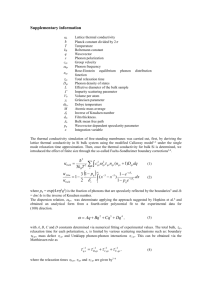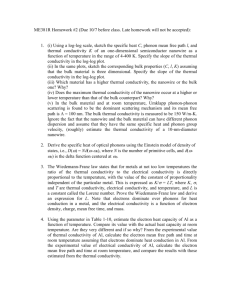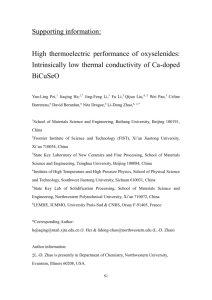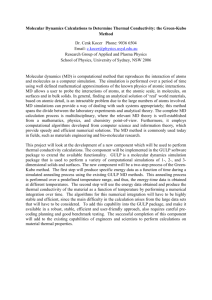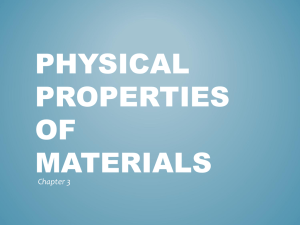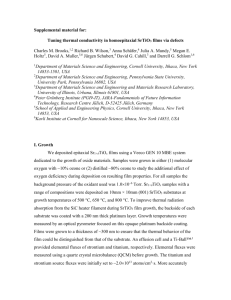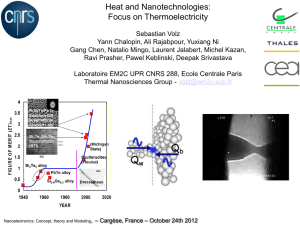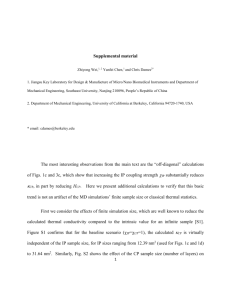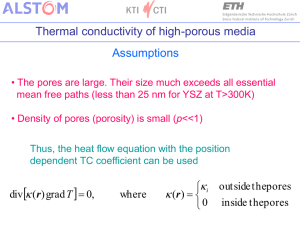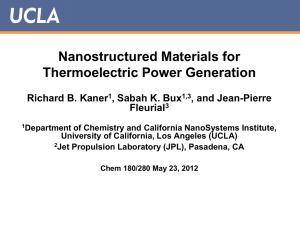ME381R Homework #1:
advertisement
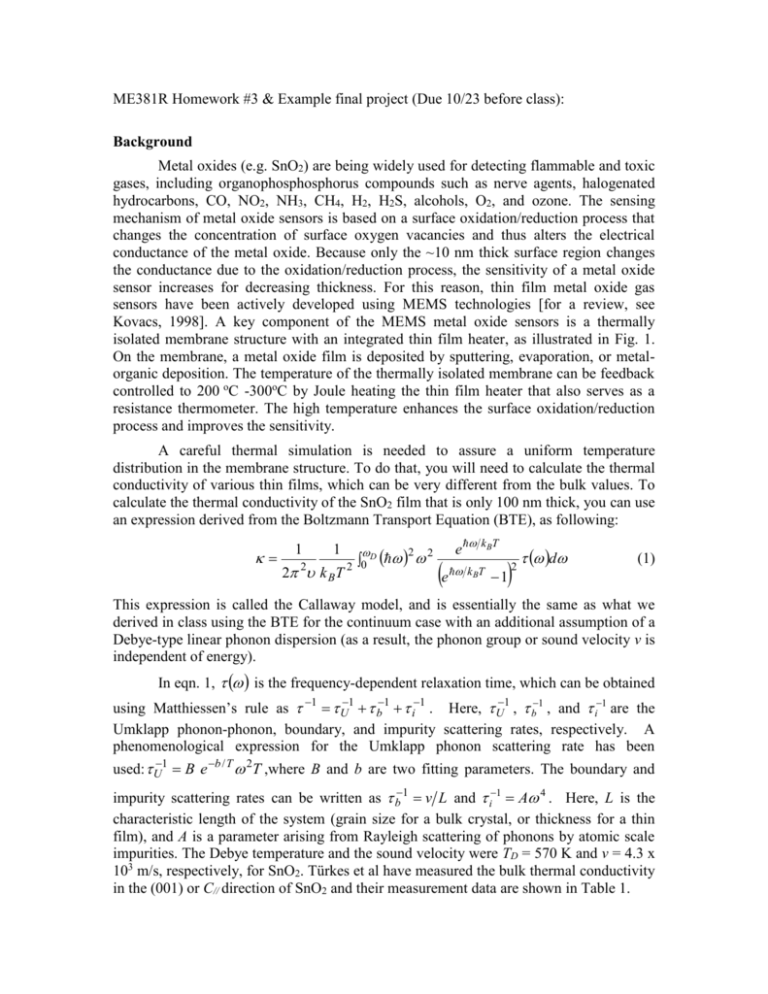
ME381R Homework #3 & Example final project (Due 10/23 before class):
Background
Metal oxides (e.g. SnO2) are being widely used for detecting flammable and toxic
gases, including organophosphosphorus compounds such as nerve agents, halogenated
hydrocarbons, CO, NO2, NH3, CH4, H2, H2S, alcohols, O2, and ozone. The sensing
mechanism of metal oxide sensors is based on a surface oxidation/reduction process that
changes the concentration of surface oxygen vacancies and thus alters the electrical
conductance of the metal oxide. Because only the ~10 nm thick surface region changes
the conductance due to the oxidation/reduction process, the sensitivity of a metal oxide
sensor increases for decreasing thickness. For this reason, thin film metal oxide gas
sensors have been actively developed using MEMS technologies [for a review, see
Kovacs, 1998]. A key component of the MEMS metal oxide sensors is a thermally
isolated membrane structure with an integrated thin film heater, as illustrated in Fig. 1.
On the membrane, a metal oxide film is deposited by sputtering, evaporation, or metalorganic deposition. The temperature of the thermally isolated membrane can be feedback
controlled to 200 oC -300oC by Joule heating the thin film heater that also serves as a
resistance thermometer. The high temperature enhances the surface oxidation/reduction
process and improves the sensitivity.
A careful thermal simulation is needed to assure a uniform temperature
distribution in the membrane structure. To do that, you will need to calculate the thermal
conductivity of various thin films, which can be very different from the bulk values. To
calculate the thermal conductivity of the SnO2 film that is only 100 nm thick, you can use
an expression derived from the Boltzmann Transport Equation (BTE), as following:
1
1
2 2 k BT 2
2 2
0 D
e
e
k BT
k BT
1
2
d
(1)
This expression is called the Callaway model, and is essentially the same as what we
derived in class using the BTE for the continuum case with an additional assumption of a
Debye-type linear phonon dispersion (as a result, the phonon group or sound velocity v is
independent of energy).
In eqn. 1, is the frequency-dependent relaxation time, which can be obtained
using Matthiessen’s rule as 1 U1 b1 i1 . Here, U1 , b1 , and i1 are the
Umklapp phonon-phonon, boundary, and impurity scattering rates, respectively. A
phenomenological expression for the Umklapp phonon scattering rate has been
used: U1 B e b / T 2T ,where B and b are two fitting parameters. The boundary and
impurity scattering rates can be written as b1 v L and i1 A 4 . Here, L is the
characteristic length of the system (grain size for a bulk crystal, or thickness for a thin
film), and A is a parameter arising from Rayleigh scattering of phonons by atomic scale
impurities. The Debye temperature and the sound velocity were TD = 570 K and v = 4.3 x
103 m/s, respectively, for SnO2. Türkes et al have measured the bulk thermal conductivity
in the (001) or C// direction of SnO2 and their measurement data are shown in Table 1.
Assignment
(1) Use eqn. 1 to calculate the thermal conductivity of bulk SnO2 in the (001)
direction as a function of temperature in the range of 10 K to 350 K. Adjust the
fitting parameters so that your calculation results fit with the measurement data.
(For your information, a Matlab code and the best fitting parameters that I have
obtained are attached below Fig. 2. In the code, I integrated eqn 1 over x
k BT
instead of )
(2) Discusses the effects of different fitting parameters on the calculated temperaturedependant thermal conductivity curve.
(3) Predict the thermal conductivity of a 100 nm thick SnO2 film as a function of
temperature. Assume: (i) the film is single crystalline in the (001) direction; (ii) its
phonon dispersion, Umklapp phonon scattering rate, impurity scattering rate is the
same as those for the bulk crystal.
Table 1: Thermal conductivity in the (001) direction of SnO2 bulk crystalline (from
P. Türkes, Ch. Pluntke, R. Helbig, J. Phys. C: Solid St. Phys. 13, 4941 (1980))
T(K)
k(W/m-K)
318.1600
83.4250
206.2700
137.6900
161.7900
174.0800
136.5800
224.8300
120.3500
239.6800
101.6100
299.8100
84.8790
391.3700
56.2040
632.3000
46.9340
879.9200
44.5110
968.5300
37.1690
1347.8000
32.7520
1452.2000
27.9530
1704.0000
20.4000
1548.2000
16.5430
1333.5000
Fig.1 Schematic diagrams of MEMS SnO2 sensors (from G. Kovas, Micromachined
Transducers Sourcebook)
Thermal conductivity (W/m-K)
2000
1500
1000
500
10
100
Temperature (K)
Fig. 2. Comparison of the measurement and my fitting results of the thermal
conductivity of SnO2 bulk crystal in the (001) direction. If I remembered correctly,
the fitting parameters were L = 6 x 10-4 m, A = 6.077 x 10-45 s3, B = 5.45 x 10-19 s/K, b
= 115.2 K.
Matlab code:
function y=conductivity()
global T L;
debye=570;
L=6e-4; % to be changed
n=1;
temperature=[2:1:350];
for T=2:1:350
temp(n)=quad(@for_integral,0,debye/T);
n=n+1;
end
temp,
temp_2=[temperature',temp'];
save('results','temp_2','-ASCII')
plot(2:1:350,temp,'+')
function y=for_integral(x)
global T L;
k_B=1.38062e-23;
h=1.05459e-34;
C=k_B/h;
v=4.3e3;
A=6.077e-45;
B=5.45e-19;
b=115.2;
y=k_B/2/pi^2/v*C^3*T^3*x.^4.*exp(x).*(exp(x)-1).^(2)./(v/L+A*C^4*x.^4*T^4+C^2*(B*exp(-1*b/T))*x.^2*T^3);

